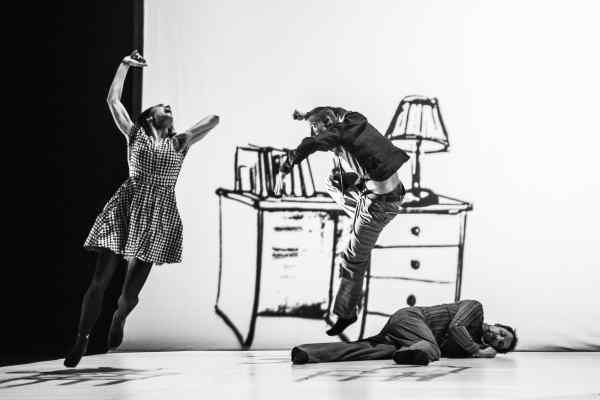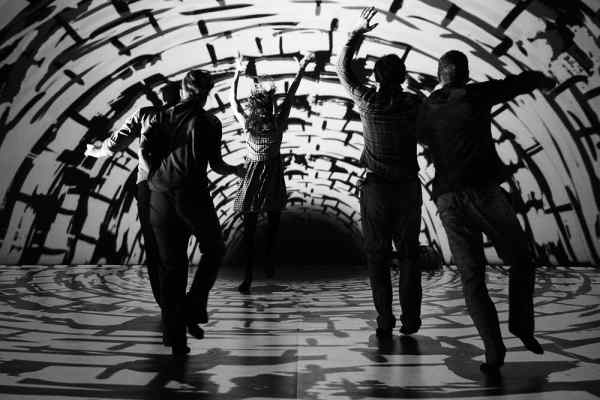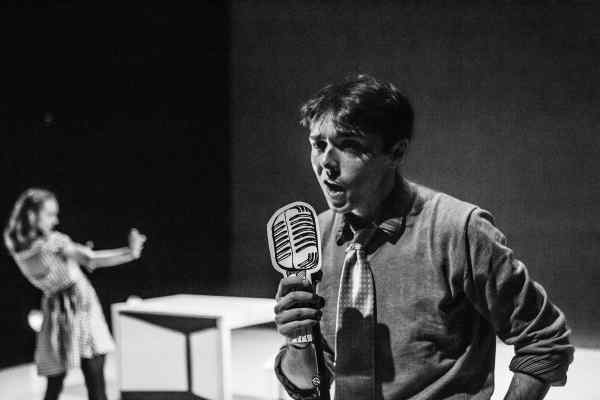 Performance of the DekkaDancers company entitled Caves and Creatures, inspired by life and work of Australian singer Nick Cave, foreshadowed in an interesting way the following events on the New Stage.
A glass colossus, which was during the last decades a dark cave that hid mysterious magic lantern - laterna magika, finally opened to daylight four years ago and within a few seasons offered to Czech audience not only the hot present, but also an outlook for the future. The possibilities of the New Stage, its strengths and weaknesses, have been used up in maximum due to conceptual dramaturgy and sophisticated management. New Stage became a haven for guesting Czech and foreign groups, its café quickly replaced the profaned Slavia and turned into a space for press conferences, professional discussions and informal meetings of leading Czech artists. The New Stage simply became a new venue of Czech theatrical culture. It opened the advent this year with the conference Theatre 3000, during which the stage was taken by illustrious names of contemporary visual art, such as Marshmallow Laser Feast and Nick Moran from the UK, Frieder Weiss from Germany, Koert Vermeulen from Belgium and others. The event provided a platform for the presentation of Czech and foreign artists and their projects in the form of lectures, presentations and workshops, offering a place for an exchange of experience and has become a source of inspiration for the general public and experts.
The first evening of the conference ended with the premiere of DekkaDancers company Caves and Creatures inspired by songs and books by Nick Cave, Australian decadent artist whose cynical melancholic expression has captured the young of the 21st century. Whether this premiere was planned with regard to Cave’s concert in Prague just a few days earlier, I do not know, but the production of the National Theatre Ballet dancers with a live singing performance sadly could not bear comparison. It is known that choreographic reworking of famous songwriters and chanson singers’ music brings many obstacles that do not always appear at first glance. The deeper and more poetic lyrics are, the easier the dance form gets stuck in superficial narratives or moods without being an equal partner to music. Although movement variations lacked originality, wit and some idea, regarding dynamic, formal and expressive side, at least they were enthusiastically performed by excellent and the committed artists. The weakest point of the piece was probably in the communication between the librettist/director (Štěpán Benyovszký) and choreographers (Viktor Konvalinka, Tom Rychetský, Tomáš Červinka).
Performance of the DekkaDancers company entitled Caves and Creatures, inspired by life and work of Australian singer Nick Cave, foreshadowed in an interesting way the following events on the New Stage.
A glass colossus, which was during the last decades a dark cave that hid mysterious magic lantern - laterna magika, finally opened to daylight four years ago and within a few seasons offered to Czech audience not only the hot present, but also an outlook for the future. The possibilities of the New Stage, its strengths and weaknesses, have been used up in maximum due to conceptual dramaturgy and sophisticated management. New Stage became a haven for guesting Czech and foreign groups, its café quickly replaced the profaned Slavia and turned into a space for press conferences, professional discussions and informal meetings of leading Czech artists. The New Stage simply became a new venue of Czech theatrical culture. It opened the advent this year with the conference Theatre 3000, during which the stage was taken by illustrious names of contemporary visual art, such as Marshmallow Laser Feast and Nick Moran from the UK, Frieder Weiss from Germany, Koert Vermeulen from Belgium and others. The event provided a platform for the presentation of Czech and foreign artists and their projects in the form of lectures, presentations and workshops, offering a place for an exchange of experience and has become a source of inspiration for the general public and experts.
The first evening of the conference ended with the premiere of DekkaDancers company Caves and Creatures inspired by songs and books by Nick Cave, Australian decadent artist whose cynical melancholic expression has captured the young of the 21st century. Whether this premiere was planned with regard to Cave’s concert in Prague just a few days earlier, I do not know, but the production of the National Theatre Ballet dancers with a live singing performance sadly could not bear comparison. It is known that choreographic reworking of famous songwriters and chanson singers’ music brings many obstacles that do not always appear at first glance. The deeper and more poetic lyrics are, the easier the dance form gets stuck in superficial narratives or moods without being an equal partner to music. Although movement variations lacked originality, wit and some idea, regarding dynamic, formal and expressive side, at least they were enthusiastically performed by excellent and the committed artists. The weakest point of the piece was probably in the communication between the librettist/director (Štěpán Benyovszký) and choreographers (Viktor Konvalinka, Tom Rychetský, Tomáš Červinka).
 Imaginative screenplay that tried to link Cave's most famous songs into a vague story of a pilgrim was supported by a very specific multimedia projection (Roman Dušek), which artfully grasped the character of presented songs and their three-dimensional effects drew the audience into the environment of the Australian landscape (excellent drawings by Jan Blažíček). However, instead of guiding the viewer through rather illusory images and moods, each short episode was unnecessarily subtitled as a chapter of a life story, as if the hero’s fate was sealed before the hero was even discovered. Direction set out clearly the scope and story for the choreographers and forced the dancers to narrate and illustrate the finished work, which wasn’t a happy solution. As if the creators forgot that the resulting shape will put dance to the forefront and the choreographer should be the one whose idea would be supported by scenery and technology (motion tracking Nicola Pavone - KinocirKus), and not predetermined. The dance sequences thus oscillated between a parody and seriously meant pantomime (we recognised the pilgrim by him carrying a bag, shaking with cold and limping on one leg, browsing through the villages was pictured as an illusion of running before the passing screen, etc.). Also, unison group variations were put en face (based on the attempt to highlight the interpretive quality of the performers and the ability to show one movement at each count), not mentioning awkward duets (fateful encounters devoid of original movement expression). Although the choreographic works of Tom Rychetský and Viktor Konvalinka have always brought a creative processes and a spark, in this piece they showed their lack of experience in “commissioned work”, thus filling the story by dance material so as to leave the superficial structure and offer a new dimension to the work.
Imaginative screenplay that tried to link Cave's most famous songs into a vague story of a pilgrim was supported by a very specific multimedia projection (Roman Dušek), which artfully grasped the character of presented songs and their three-dimensional effects drew the audience into the environment of the Australian landscape (excellent drawings by Jan Blažíček). However, instead of guiding the viewer through rather illusory images and moods, each short episode was unnecessarily subtitled as a chapter of a life story, as if the hero’s fate was sealed before the hero was even discovered. Direction set out clearly the scope and story for the choreographers and forced the dancers to narrate and illustrate the finished work, which wasn’t a happy solution. As if the creators forgot that the resulting shape will put dance to the forefront and the choreographer should be the one whose idea would be supported by scenery and technology (motion tracking Nicola Pavone - KinocirKus), and not predetermined. The dance sequences thus oscillated between a parody and seriously meant pantomime (we recognised the pilgrim by him carrying a bag, shaking with cold and limping on one leg, browsing through the villages was pictured as an illusion of running before the passing screen, etc.). Also, unison group variations were put en face (based on the attempt to highlight the interpretive quality of the performers and the ability to show one movement at each count), not mentioning awkward duets (fateful encounters devoid of original movement expression). Although the choreographic works of Tom Rychetský and Viktor Konvalinka have always brought a creative processes and a spark, in this piece they showed their lack of experience in “commissioned work”, thus filling the story by dance material so as to leave the superficial structure and offer a new dimension to the work.
 Although the premiere of DekkaDancers was not the highlight of this year's choreographic harvest, the aim to give young artists the opportunity to work with multimedia technology of laterna magika and to show the possibility of its scenic use not only enriched the discussions at the Theatre 3000 conference, but also confirmed the dramaturgy of New Stage to become a space for experimentation and theatrical development.
However, because the dangerous creatures must be driven back into the cave, the National Theatre decided one day after the successful conference to end the promising future of the New Stage as an international platform for the new theatre communication from the New Year and to pass the leadership to the drama section of NT which has an aim to change the futuristic complex to a scene of small theatrical forms and chamber drama with emphasis on the Czech repertoire. We can only thank the leaving director of the New Stage Štěpán Kubišta for bold steps that revived during several seasons the cultural dialogue of the leading Czech scene, and enjoy the consequences his short tenure has brought to our theatre. And also hope that the next fate of this contradictory building will not be a dreaded step back, but will bring a new perspective on contemporary cultural creation of the young generation.
Written from the premiere on 2nd December 2013, New Stage of the National Theatre.
Caves and Creatures
Although the premiere of DekkaDancers was not the highlight of this year's choreographic harvest, the aim to give young artists the opportunity to work with multimedia technology of laterna magika and to show the possibility of its scenic use not only enriched the discussions at the Theatre 3000 conference, but also confirmed the dramaturgy of New Stage to become a space for experimentation and theatrical development.
However, because the dangerous creatures must be driven back into the cave, the National Theatre decided one day after the successful conference to end the promising future of the New Stage as an international platform for the new theatre communication from the New Year and to pass the leadership to the drama section of NT which has an aim to change the futuristic complex to a scene of small theatrical forms and chamber drama with emphasis on the Czech repertoire. We can only thank the leaving director of the New Stage Štěpán Kubišta for bold steps that revived during several seasons the cultural dialogue of the leading Czech scene, and enjoy the consequences his short tenure has brought to our theatre. And also hope that the next fate of this contradictory building will not be a dreaded step back, but will bring a new perspective on contemporary cultural creation of the young generation.
Written from the premiere on 2nd December 2013, New Stage of the National Theatre.
Caves and CreaturesWritten, directed by: Štěpán Benyovszký
Choreography: Tom Rychetský, Viktor Konvalinka, Tomáš Červinka
Video art and motion tracking: Nicola Pavone
Projection: Roman Dušek
Light design: Dan TesařArt Supervision: Pavel Hejný
Drawings: Jan Blažíček
Production: Zuzana Hájková
Premiere: 2nd December 2013



Josef Bartos
Thank you for your thoughts. One got stuck in my mind – that passion makes us different from AI. Just yesterday I read…I am a dance critic. I am a member of an endangered species